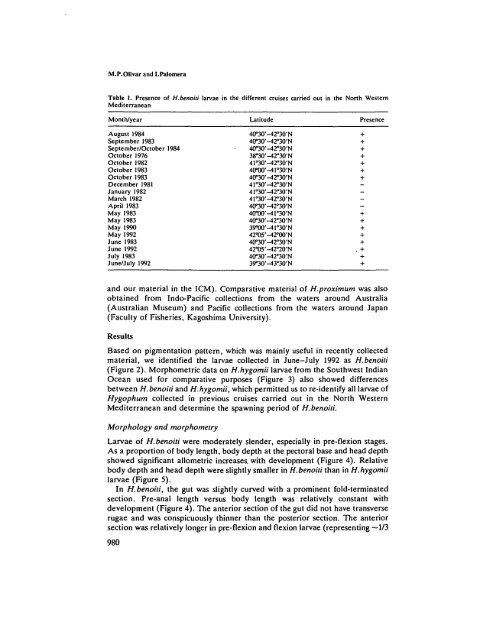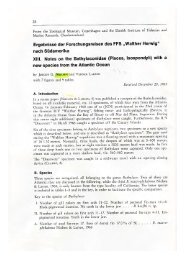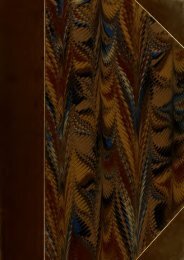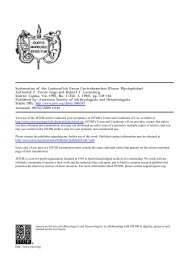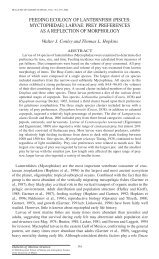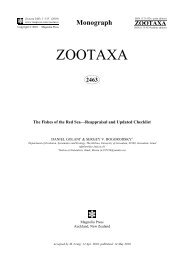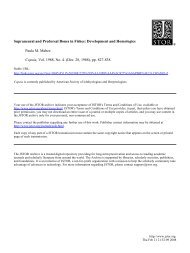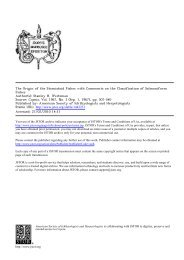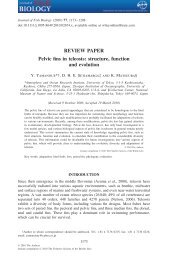Ontogeny and distribution of Hygophum benoiti (Pisces ...
Ontogeny and distribution of Hygophum benoiti (Pisces ...
Ontogeny and distribution of Hygophum benoiti (Pisces ...
You also want an ePaper? Increase the reach of your titles
YUMPU automatically turns print PDFs into web optimized ePapers that Google loves.
M.P.OIivar <strong>and</strong> I.Palomera<br />
Table I. Presence <strong>of</strong> H.<strong>benoiti</strong> larvae in the different cruises carried out in the North Western<br />
Mediterranean<br />
Month/year Latitude Presence<br />
August 1984 40°30'-42°30'N +<br />
September 1983 40°30'-42°30'N +<br />
September/October 1984 40"30'-42°30'N +<br />
October 1976 38°30'-42°30'N +<br />
October 1982 41°30'-42°30'N +<br />
October 1983 40°00'-41°30'N +<br />
October 1983 40°30'-42°30'N +<br />
December 1981 41°30'-42°30'N<br />
January 1982 41°30'-42°30'N<br />
March 1982 41°30'-42°30'N<br />
April 1983 40°30'-42°30'N<br />
May 1983 40 o 00'-41 o 30'N +<br />
May 1983 40°30'-42°30'N +<br />
May 1990 39°0O'-41°30'N +<br />
May 1992 42°05'-42°00'N +<br />
June 1983 40°30'-42°30'N +<br />
June 1992 42°05'-42 1> 20'N . +<br />
July 1983 40°30'-42 o 30'N +<br />
June/July 1992 39°30'-43°30'N +<br />
<strong>and</strong> our material in the ICM). Comparative material <strong>of</strong> H.proximum was also<br />
obtained from Indo-Pacific collections from the waters around Australia<br />
(Australian Museum) <strong>and</strong> Pacific collections from the waters around Japan<br />
(Faculty <strong>of</strong> Fisheries, Kagoshima University).<br />
Results<br />
Based on pigmentation pattern, which was mainly useful in recently collected<br />
material, we identified the larvae collected in June-July 1992 as H.<strong>benoiti</strong><br />
(Figure 2). Morphometric data on H.hygomii larvae from the Southwest Indian<br />
Ocean used for comparative purposes (Figure 3) also showed differences<br />
between H.<strong>benoiti</strong> <strong>and</strong> H.hygomii, which permitted us to re-identify all larvae <strong>of</strong><br />
<strong>Hygophum</strong> collected in previous cruises carried out in the North Western<br />
Mediterranean <strong>and</strong> determine the spawning period <strong>of</strong> H.<strong>benoiti</strong>.<br />
Morphology <strong>and</strong> morphometry<br />
Larvae <strong>of</strong> H.<strong>benoiti</strong> were moderately slender, especially in pre-flexion stages.<br />
As a proportion <strong>of</strong> body length, body depth at the pectoral base <strong>and</strong> head depth<br />
showed significant allometric increases, with development (Figure 4). Relative<br />
body depth <strong>and</strong> head depth were slightly smaller in H.<strong>benoiti</strong> than in H.hygomii<br />
larvae (Figure 5).<br />
In H.<strong>benoiti</strong>, the gut was slightly curved with a prominent fold-terminated<br />
section. Pre-anal length versus body length was relatively constant with<br />
development (Figure 4). The anterior section <strong>of</strong> the gut did not have transverse<br />
rugae <strong>and</strong> was conspicuously thinner than the posterior section. The anterior<br />
section was relatively longer in pre-flexion <strong>and</strong> flexion larvae (representing ~l/3<br />
980


